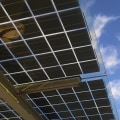Thin film solar panels have been gaining popularity in recent years as a promising alternative to traditional silicon-based solar panels. These panels use thin layers of photovoltaic materials, such as cadmium telluride or copper indium gallium selenide, to convert sunlight into electricity. They are lightweight, flexible, and can be easily integrated into building materials, making them a versatile option for harnessing solar energy. As the demand for renewable energy continues to rise, thin film solar panels are poised to play a crucial role in meeting our energy needs.
In this article, we will explore the advancements in solar panel technology and the potential of new panel designs and materials, specifically focusing on thin film solar panels. So, let's dive in and discover the future of renewable energy with thin film solar panels. Firstly, let's define what thin film solar panels are. Unlike traditional solar panels that use thick layers of silicon to convert sunlight into electricity, thin film solar panels use a thin layer of photovoltaic (PV) material, such as amorphous silicon or cadmium telluride, to generate power. This not only makes them more flexible and lightweight, but also more efficient and cost-effective compared to traditional panels.
Additionally, thin film solar panels are easier to install and have a lower carbon footprint, making them a greener option for those looking to reduce their environmental impact. Now, let's dive into the main advantages of using thin film solar panels. The first and most obvious benefit is their improved efficiency. Due to their design, thin film panels are able to absorb a wider range of sunlight wavelengths, making them more effective even in low light conditions. This means that they can produce more electricity per square foot compared to traditional panels, resulting in higher energy output and cost savings for users.
Additionally, their flexibility allows for easy integration into various surfaces such as rooftops, windows, and even vehicles, making them a versatile option for both residential and commercial properties. Another important aspect to consider when investing in solar panels is the cost. Thin film solar panels are significantly cheaper to produce compared to traditional panels, as they require less material and energy during the manufacturing process. This cost-effectiveness translates into savings for consumers, making solar energy more accessible and appealing to a wider audience. In terms of installation, thin film solar panels have a much simpler and quicker installation process compared to traditional panels. Their lightweight and flexible design means that they can be easily mounted on various surfaces, reducing installation time and costs.
This makes them an ideal choice for those looking to switch to solar energy without the hassle of a lengthy installation process. Now, let's address some potential concerns that people may have about thin film solar panels. One common concern is their durability and lifespan. While it is true that thin film panels have a slightly shorter lifespan compared to traditional panels, advancements in technology have significantly improved their durability and reliability. Additionally, most manufacturers offer warranties and maintenance services for their products, providing peace of mind for consumers. In conclusion, thin film solar panels are a game-changer in the renewable energy industry.
Their efficiency, cost-effectiveness, and flexibility make them a highly attractive option for both residential and commercial properties. As technology continues to advance, we can expect to see even more improvements in thin film solar panel design and performance, further solidifying their position as the future of renewable energy.
Versatility and Ease of Installation
Thin film solar panels offer a versatile and easy solution for harnessing solar energy. Unlike traditional solar panels, which are rigid and bulky, thin film panels can be installed on various surfaces, including curved or irregular ones. This makes them ideal for unconventional spaces, such as rooftops, facades, and even vehicles.The installation process for thin film panels is also simpler and less time-consuming compared to traditional panels. They can be easily adhered or attached using adhesive strips, making them a convenient option for both residential and commercial installations. With their versatility and ease of installation, thin film solar panels are paving the way for more accessible and widespread use of solar energy.
Durability and Maintenance
One of the common concerns about thin film solar panels is their durability and lifespan. As these panels are made from thinner and more flexible materials compared to traditional solar panels, there is a misconception that they may not last as long. However, this is not the case.Thin film solar panels have been proven to be durable and long-lasting, with some manufacturers offering warranties of up to 25 years. These panels are designed to withstand harsh weather conditions, including high winds and heavy snow loads. In terms of maintenance, thin film solar panels require very little upkeep. Unlike traditional solar panels, they do not have any moving parts that can wear out or break. This means that there is less risk of mechanical failure and the need for costly repairs.
Additionally, many solar panel installation companies offer maintenance services for thin film panels, ensuring that they remain in top condition for optimal energy production.
Efficiency and Cost Savings
Thin film solar panels have been gaining popularity for their efficiency and cost savings compared to traditional solar panels. These panels are made by depositing a thin layer of photovoltaic material onto a substrate, which allows for a more flexible and lightweight design. This flexibility not only makes them easier to install, but also allows for more surface area coverage, making them more efficient in converting sunlight into electricity. In terms of cost savings, thin film solar panels require less material and labor to produce, which reduces the overall cost. Additionally, their lightweight design means they can be installed on a wider range of surfaces, making them a more versatile option for both residential and commercial properties.This means that not only are they more affordable, but they can also be installed in more locations, maximizing their potential for energy production. Furthermore, thin film solar panels have a longer lifespan compared to traditional panels, with some manufacturers claiming up to 25 years of use. This means that not only are they more efficient and cost-effective upfront, but they also provide long-term savings by reducing the need for frequent replacements. In summary, thin film solar panels offer numerous benefits and advancements in solar technology. From their improved efficiency and cost savings to their versatility and ease of installation, it's clear that they are the future of renewable energy. As more and more people make the switch to solar power, we can expect to see a significant impact on the environment and our reliance on traditional energy sources.
So if you're considering solar energy for your home or business, be sure to explore the option of thin film solar panels.


